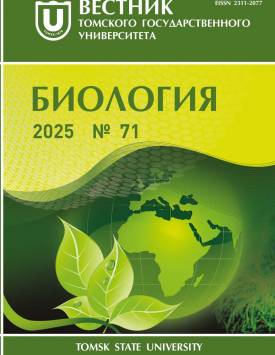Breeding records of the Pygmy Cormorant Phalacrocorax pygmeus (Pallas, 1773) and Glossy Ibis Plegadis falcinbellus (Linnaeus, 1766) in the Kurgan Oblast (Western Siberia)
In June 2025, we conducted a survey of large joint colony of Great White Egret Casmerodius albus (about 100 pairs) and Grey Heron Ardea cinerea (about 70 pairs) located on Lake Malye Donki in the Kurtamysh district of Kurgan Oblast (N54°36’, E64°24’). It is one of the largest freshwater reservoirs in the region with the area of 43.7 km2 and a characteristic floodplain type of overgrowing. A DJI Mavic 2 Zoom quadcopter (SZ DJI Technology Co., Ltd., Chine) was used for his examination. During the survey on June 18 was found a very compact settlement of the Pygmy Cormorant (6 nests) and Glossy Ibis (4 nests), which could fit on an area measuring 1.0 x 2.7 m (See Fig. 1 in the Supplement). The nests were built on reed beds in the most densely populated part of the heron’s colony, at a distance of less than 1 m from the nearest nests of the latter (See Fig. 2 in the Supplement). The cormorants, frightened from their nests, did not fly up, but dived from them into the water, which indicates a fairly large depth in this place. Their nests towered above the water by more than 0.5 m (See Fig. 3 in the Supplement), the height of the nests of the Glossy Ibises was half as high (See Fig. 4 in the Supplement). The distance between any neighboring nests in the settlement was 0.2-0.3 m. It is characteristic that the Glossy Ibises did not settle next to each other, their nests were located between the nests of Cormorants - at a distance of 0.8-0.9 m from each other. The nests of both species contained eggs and newly hatched chicks. Complete clutches of the Pygmy Cormorants contained 4-6 eggs, clutches of the Glossy Ibises - 4-8 eggs (See Fig. 5 in the Supplement). Both species were found nesting in Kurgan Oblast and the entire Asian part of Russia for the first time. Our records indicate the expansion of the breeding ranges of the Pygmy Cormorant and Glossy Ibis to the forest-steppe Trans-Urals - more than one thousand km northeast of the nearest previously known breeding grounds, which are located in the lower reaches of the Volga, Ural rivers, and Central Kazakhstan. Since the beginning of this century, they have shown a clear tendency to settle. This confirms the general trend of changes in the distribution of birds of the wetland complex, which emerged in Western Siberia in the last 3-4 decades, and allows us to expect new similar records. The article contains 1 Supplement, 9 References. The Author declares no conflict of interest.
Keywords
distribution, birds, nesting, range dynamics, limnophilic species, climate change, global warmingAuthors
| Name | Organization | |
| Tarasov Vladimir V. | Institute of Plant and Animal Ecology, Ural Branch of the Russian Academy of Sciences | grouse@bk.ru |
References

Breeding records of the Pygmy Cormorant Phalacrocorax pygmeus (Pallas, 1773) and Glossy Ibis Plegadis falcinbellus (Linnaeus, 1766) in the Kurgan Oblast (Western Siberia) | Vestnik Tomskogo gosudarstvennogo universiteta. Biologiya - Tomsk State University Journal of Biology. 2025. № 71. DOI: 10.17223/19988591/71/15
